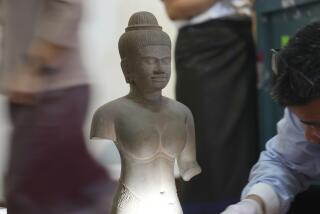Egyptian antiquities find way out of the closet
- Share via
NEW YORK — With more than 4,000 Egyptian antiquities, the Brooklyn Museum of Art has one of the finest collections in the world. But only a fraction, about 500 or so items, has ever been on display.
That changed Saturday, when “Egypt Reborn: Art for Eternity” opened at the museum, an exhibit featuring more than 600 additional antiquities in newly renovated galleries. Some of the items are being shown for the first time in decades, others for the first time ever.
The desire to display more of the museum’s vast holdings spurred the museum to convert offices and storage areas into new exhibition space, curator James Romano said.
“How can we keep these things hidden?” he said. “Any basic book on Egyptian art is going to have at least 10 of the items in this room.”
The galleries in place before this exhibit focused on art from the later stages of ancient Egypt, from about 1390 BC to about 30 BC.
With Saturday’s opening, which heralded the expansion of Egyptian exhibition space to an area the size of two city blocks, the museum can now present a survey of Egyptian art that dates to the first settlers in the region. The oldest artifact in the exhibit, an ivory statuette of a male figure, is dated to about 3800 BC.
The new installation has two sections, one chronological and the other thematic. The thematic section, a visitor’s introduction to the show, uses pieces throughout the timeline to explore style and form.
“The story we are trying to tell is about permanence and change, how some aspects of material culture remain consistent and some things change constantly,” Romano said.
The expansion has been planned since August 1995, when Romano first started looking at the museum’s holdings to determine their condition and decide which ones should be exhibited.
The new galleries are housed in a section of the museum that was office space and storage until recently. The space was cleared out earlier this year, with offices consolidated and moved to other parts of the museum.
The museum put a variety of items in the new exhibition space -- statues, jewelry, weapons, pottery, coffins, tools.
Among the objects on view for the first time are personal effects, such as tweezers and a razor, and Romano’s own favorite piece: a wooden spoon in the form of an outstretched woman, carved so intricately that the hair on her head is visible.
“It was literally falling apart,” he said. “We could never exhibit until we had the will and the financial resources to restore it.”
More to Read
The biggest entertainment stories
Get our big stories about Hollywood, film, television, music, arts, culture and more right in your inbox as soon as they publish.
You may occasionally receive promotional content from the Los Angeles Times.










